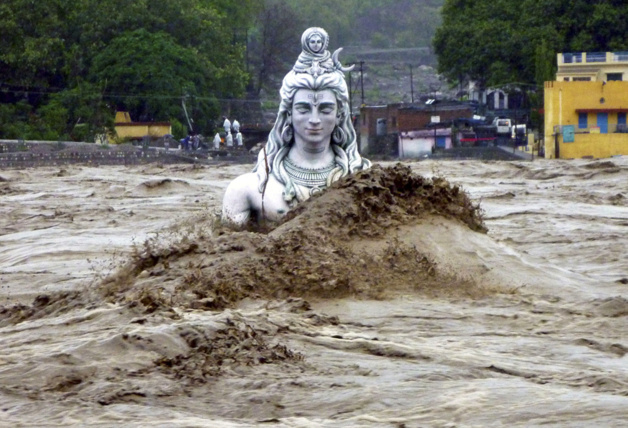
Statue of god Shiva under water - Photo The Atlantic
Over the past 10 days, rescue operations have been carried out in full swing even with the army being brought into the loop. This state which plays host for many Hindu pilgrim spots including the famous Badrinath and Kedarnath witnessed a flash flood on June 16. Most of the places were cut off from all contact to the outside world. Of nearly 15,000 villages in the state, a little more than 300 could be accessed. Food packages were dropped to the stranded tourists and pilgrims apart from carrying out rescue operations. More than half of the pilgrims made their way back and as the flood starts receding gradually, the authorities are in the fear of finding more dead bodies. A phase of the mass burial for the victims was conducted with honours.
The politicians in their part made some attempts to politicize the issue. The incumbents, in particular resorted to political mud-slinging when the possible Prime Ministerial candidate for the BJP (Bharathiya Janata Party) aided in rescue of pilgrims in Uttarakhand. Some key political leaders even cynically labeled him as “Rambo” for his efforts in the rescue operation.
The politicians in their part made some attempts to politicize the issue. The incumbents, in particular resorted to political mud-slinging when the possible Prime Ministerial candidate for the BJP (Bharathiya Janata Party) aided in rescue of pilgrims in Uttarakhand. Some key political leaders even cynically labeled him as “Rambo” for his efforts in the rescue operation.
A disaster on all-fronts
A few days into the rescue operations, the weather was increasingly worsening. During one such operation, a helicopter of the Indian Air Force (IAF) crashed down killing 20 people including defense personnel on board.
Adding to the woes of the rescue team which has faced quite a number of obstacles, a mild earthquake of magnitude 3.5 struck the state. The authorities have a reason to fear, as the state is categorized as a “high-risk” area. There is also a threat of landslides in hilly areas with the valleys being further affected.
Authorities have attributed a timeline of 3 years for the affected areas to be back to its normalcy. One higher bureaucrat from the state government also reflects on the non-adherence of rules while constructing buildings. The pilgrim spots of Kedarnath and Badrinath would also take time to rebuild, making it difficult for pilgrims who throng the place all around the year.
Setting the rescue and rehabilitation aside, there is a risk of an epidemic in the affected area. With the dead bodies stuck in the silt, there could be a decay intruding into the water bodies making it prone to diseases. The speaker of Uttarakhand’s assembly believes the death toll to reach as high as 10,000. However, the Chief Minister is ambiguous about the number of victims and attributes around 1,000 to be killed in the calamity. The news from centre is all the more different, with the Home Minister stating the number to be 900.
Adding to the woes of the rescue team which has faced quite a number of obstacles, a mild earthquake of magnitude 3.5 struck the state. The authorities have a reason to fear, as the state is categorized as a “high-risk” area. There is also a threat of landslides in hilly areas with the valleys being further affected.
Authorities have attributed a timeline of 3 years for the affected areas to be back to its normalcy. One higher bureaucrat from the state government also reflects on the non-adherence of rules while constructing buildings. The pilgrim spots of Kedarnath and Badrinath would also take time to rebuild, making it difficult for pilgrims who throng the place all around the year.
Setting the rescue and rehabilitation aside, there is a risk of an epidemic in the affected area. With the dead bodies stuck in the silt, there could be a decay intruding into the water bodies making it prone to diseases. The speaker of Uttarakhand’s assembly believes the death toll to reach as high as 10,000. However, the Chief Minister is ambiguous about the number of victims and attributes around 1,000 to be killed in the calamity. The news from centre is all the more different, with the Home Minister stating the number to be 900.
China, a bird of prey
The geographical area of Uttarakhand also does no good to the calamity with a threat of Chinese intrusion rising by the day. The state is a central sector of Sino-Indian border and makes up for 545 kms of the stretch of 4,057 kms. Due to the flood, Indian Army outposts and formations have practically become inaccessible. With the People’s Liberation Army (PLA) of China having the capability of mobilizing nearly 15,000 troops along the Line of Actual Control (LAC), India has to be on the high alert. Adding to the woes of the Army, communications to most outposts have been affected and very few outposts can be reached, even by foot or air.
With broken roads, bridges leave India’s northern frontier open to Chinese incursions. Reportedly, the Army is working overtime to rebuild the nation’s key infrastructure.
With broken roads, bridges leave India’s northern frontier open to Chinese incursions. Reportedly, the Army is working overtime to rebuild the nation’s key infrastructure.




























